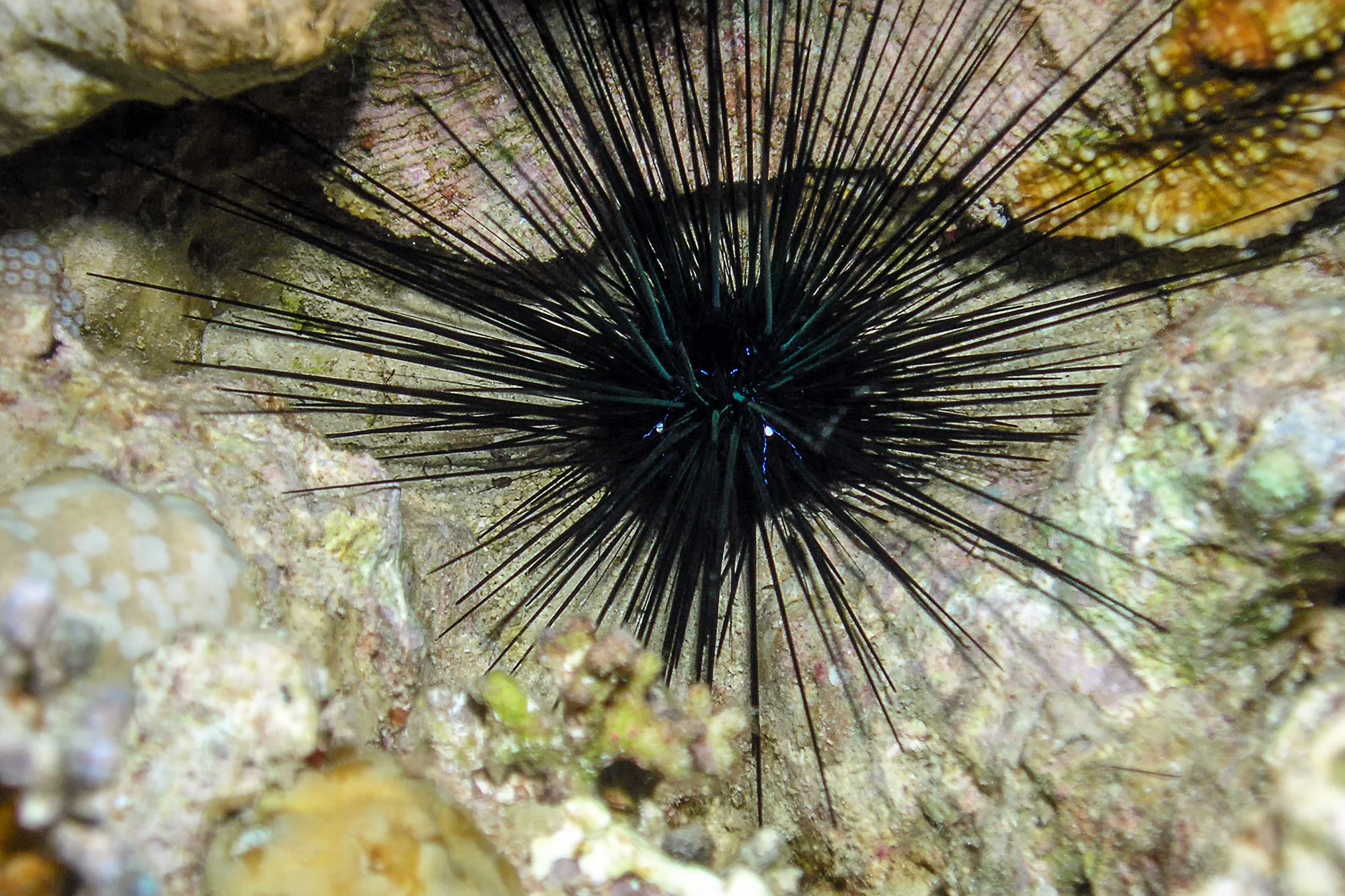
Un organismo unicellulare, lo scuticociliato, è stato identificato come la causa della morte di massa nel 2022 di ricci di mare dalle lunghe spine nei Caraibi e sulla costa orientale della Florida. Questi ricci sono essenziali per la salute delle barriere coralline e la scoperta solleva interrogativi sulla presenza di ciliati, sulle loro condizioni di crescita e sul loro potenziale impatto su altre specie. Fotografia del riccio di mare lungo e spinoso (Diadema antillarum).
La morte di massa del riccio di mare dalle lunghe spine, una perdita che minaccia la salute delle barriere coralline dai Caraibi alla costa orientale della Florida, è stata causata da un organismo unicellulare chiamato ciliato.
Nel 2022 è terminata la caccia all’assassino che ha spazzato via i ricci di mare dalle lunghe spine nei Caraibi e lungo la costa orientale della Florida. Un team di ricercatori organizzato da Mia Breitbart, Distinguished University Professor presso il College of Marine Sciences della University of South Florida, ha identificato un organismo unicellulare chiamato ciliare come causa della morte massiccia di un animale marino vitale per la salute della barriera corallina.
I loro risultati sono stati pubblicati il 19 aprile sulla rivista Nature
Ciliate culture viewed under the microscope. Credit: Mya Breitbart USF College of Marine Science
“We’re beyond thrilled to get to the bottom of the 2022 mystery and a bit stunned we did it so quickly,” said Breitbart, senior author on the Science Advances study and an expert in marine genomics. “We had a great team in place and the tools needed to do the ocean science equivalent of a forensic investigation.”
Ciliates are microscopic organisms covered in hair-like structures called cilia that help them move and eat. They are found almost anywhere there is water and most are not disease-causing agents. However, this specific species of ciliate – called a scuticociliate – has been implicated in die-offs of other marine species, such as sharks, in the past.

Photo compilation showing the same sea urchin before and after infection with the ciliate in the USF aquarium research facility. Credit: Makenzie Kerr USF College of Marine Science
Examining urchins collected from 23 sites in the Caribbean, the research team used a series of techniques to confirm the source of the die-off event.
After identifying the ciliate in every affected urchin specimen using genomic techniques, the team grew ciliates in the lab and performed infection experiments at the USF College of Marine Science. When the pathogen was introduced to otherwise healthy urchins in an aquarium tank, the urchins died within a few days – replicating what was taking place in the ocean and confirming the ciliate as the disease source.

DaSc-affected sea urchin, Aruba, August 2022. Credit: Ian Hewson Cornell University
“We’re excited to share this information with everyone, from reef managers to additional scientists so we can explore it further and try to stop its spread,” Breitbart said.

Mya Breitbart (USF) viewing the ciliate culture by microscopy. Credit: Makenzie Kerr USF College of Marine Science
The long-spined sea urchins inhabit shallow tropical waters and feed on algae that would otherwise destroy a reef. They began to lose their spines within days of contracting an unknown disease and died in droves starting in January 2022.
A similar die-off event took place in the early 1980s, which wiped out 98 percent of the long-spined sea urchin population. The culprit of that die-off remains a mystery.
Breitbart first got the call about the unfolding die-off at the end of March 2022. She immediately assembled a team consisting of Ian Hewson, lead author on the publication and a marine ecologist at Cornell University; Christina Kellogg, a microbiologist from the U.S. Geological Survey in St. Petersburg, Fla. who has worked extensively on coral reef diseases; and USF graduate student Isabella Ritchie.
“At the time, we didn’t know if this die-off was caused by pollution, stress, something else – we just didn’t know,” said Hewson, an expert in diseases that cause mass die-offs of sea stars, who flew from New York to the Caribbean Islands to observe the situation.
Even with the source of the mysterious die-off uncovered, questions still remain. For example:
- Is this ciliate new to the area, or was it there prior to the die-off?
- If it has been there, what environmental conditions favored its growth and why did it infect the urchins?
- Can it affect other species of urchins?
“Una teoria che abbiamo è che il ciliato è cresciuto bene nelle condizioni di alta produttività osservate nei Caraibi quando ha iniziato a svanire”, ha detto Kellogg. “Siamo anche curiosi del fatto che ci sia una certa sovrapposizione in alcune delle aree geografiche in cui si è verificata questa estinzione e dove le barriere coralline sono in declino a causa della malattia della perdita di tessuto di corallo roccioso”.
Riferimento: “L’agente scuticocilato causa la mortalità di massa del Diadema Antillarum nel Mar dei Caraibi” di Ian Hewson, Isabella T Ritchie, James S Evans, Ashley Alterra, Donald Berenger, Irene Bowman, Marilyn Brandt, Kayla A. Budd e Rolio A. Camacho, Thomas O. Cornwell, Peter D. Kimani A. Kitson-Walters, Patricia Kramer, Judith C.Lang, Harilaos Lessios, Lauren Liddy, David Marancik, Stephen Nimrod, Joshua T. Patterson, Marit Pistor, Isabel C. Romero, Rita Sellares-Blasco, Moriah LB Sevier, William Sharp, Matthew Souza, Andrina Valdez-Trinidad, Maren van der Laan, Brian Villanova-Cuevas, Maria Villalpando, Sarah de Von Huene, Matthew Warham, Tom Weyers, Stacy M. Yanong, Soumira Zambrano, Alise Zimmerman, Mia Breitbart 19 aprile 2023 Disponibile qui. La scienza avanza.
DOI: 10.1126/sciadv.adg3200
La ricerca è stata finanziata dalla National Science Foundation, dall’Atkinson Rapid Response Center for Sustainable Futures, dall’AGGRA, dalla National Oceanic and Atmospheric Administration, dalla National Fish and Wildlife Foundation, dalla Florida Keys Marine Preserve e dalla Florida Fish and Wildlife Commission.

“Devoto esploratore. Pluripremiato sostenitore del cibo. Esasperante umile fanatico della tv. Impenitente specialista dei social media.”




More Stories
Gli scienziati di Cambridge svelano una nuova teoria sulle origini degli elementi costitutivi della vita
Hubble celebra il suo 34° anniversario con una vista mozzafiato della Nebulosa Piccolo Manubrio
Sepolta nella Nebulosa Artiglio di Gatto c'è una delle particelle spaziali più grandi mai viste